Journey / biarritz - marseille
Les liaisons dangereuses
Rob Bound reporting from France: What happens when you put Monocle’s Culture editor and a mysterious companion in a Jaguar and launch them on a sojourn through France from Biarritz to Marseille? On reflection it’s probably best not to ask
You’ve chosen to go on a roadtrip so you’ll need a road. Which road? The West Coast’s a convoy of Brits in Mustangs doing Kerouac-lite (not that I’m above it). Paris-Dakar? They spent 100 years perfecting the motor car in order to break it, dramatically, in a desert at 150mph. The French Riviera in a Rolls Corniche? Classic, sure, but too much so – and anyway, my barber is fresh out of hair pomade and moustache wax.
But you’re getting warmer: we’re in France. We’ll drive from Biarritz to Marseille via the Pyrénées; the Côte des Basques to the Côte d’Azur via the Col d’Aspin; from the cold, salty Atlantic to the soapy-blue Med via snowcaps and crags.
You’ve chosen a roadtrip so you will need a cool co-pilot. Unfortunately no cool ones were available so welcome to the show, Jules (he wears Aviators like the car’s a plane; like I meant “co-pilot”). You’ll need a map (or four). We’ve got Michelin’s 524 to 527: Aquitaine, Midi-Pyrénées, Languedoc-Roussillon and Provence-Alps-French Riviera. And you’ll need wheels so we’ll take the Jag.
Biarritz: what is it? It sounds like “glitz” and its reputation for faded glamour is inviting; the resort for royalty, good families and their governesses, discreet misbehaviour (grande dames et garçons du piscine), heirs and Princess Graces. Biarritz sealed the deal on 19th-century society top honours when Napoleon III had Couvrechef build the Villa Eugénie for his Spanish-born empress so she would be embedded in France but near enough to Basque Spain to be able to wake up and smell the chorizo. The coastline has history: Louis xiv married Princess Maria Theresa of Spain in 1660 to bind an earlier trans-Pyrénéen alliance down the sand in St Jean de Luz. In the 1950s Deborah Kerr’s husband, the screenwriter Paul Viertel, came to Biarritz to make a movie, saw the surf and had his board sent over from California on the next jet. So far, so sun-kissed’n’sexy.
Is it still faded, the glamour of Biarritz? Not if the new glamour is cool. Now, maybe thanks to Viertel, Biarritz is all about surfing. The old destination for brisk seawater cures became the seaside of top-hatted promenades and has now become the beach. You won’t see the bronzed bums of Ipanema (I did initially want my money back) but you’ll see the wet-suited athleticism of Tarifa, Bondi and Santa Monica.
Between the Hôtel du Palais (Empress Eugénie’s old villa) and the casino stretches the heart of Biarritz: La Grand Plage. The ceaseless sea is always addictive but this section of the ocean is worth watching for the Atlantic giving good surf all day; you can dip your board into the brine before work, at lunchtime and in the late afternoon. I say “lunchtime”: it’s best stretched out and spent with Arcachon oysters and sea bass and sweet muscat at Chez Albert. Meanwhile, down on the beach, the girls watch the boys in the water while the boys pretend no one’s looking but strip down to demi-wetsuit at every opportunity to show what fighting the tide and balancing a board and plenty of attitude can do for the pectorals and the abdominals. The école de sauvetage is another perfect picture of learning the ropes of derring-do in arrestingly abbreviated swimsuits and shorts in lifeguard-standard red and yellow. At Chez Albert we skip dessert.
Biarritz is miscellaneous: grand hotels; big villas; rococo flourishes; palms and pollarded planes; formal parks; and bits of heavy-gabled Pyrénéen mountain architecture that have slid quite a few miles down the hill. Fragrant old ladies with small dogs and salty-haired dudes with surfboards are polite to each other outside the tabac. There is a cinema (the Royal), a proper record shop (Pet Records; would Pet Sounds have worked too well?) and some nice little surf-ish places selling boards, trainers, big T-shirts and wave-porn magazines – and, of course, everything bar the restaurants and the sea itself is closed for lunch. Later there will be a purple-lit strip joint and an Irish pub but Biarritz is the sort of place that makes you feel licentious going for a nightcap in the casino at witching hour. The waves crash, the beam of the lighthouse swoops through the parting night and France’s surf capital feels gothic.
Rousing the Jag from slumber makes a good noise in the cavernous underground casino carpark and we roar towards the hills with Air in our ears and a whole trip in the offing. Farmland suddenly surrounds you in France; crops, animals, tractors, 100 signs advertising honey and eggs and, as the climb gets steeper, sheep’s cheese, then goat’s, then – what next? Cuckoo clocks?
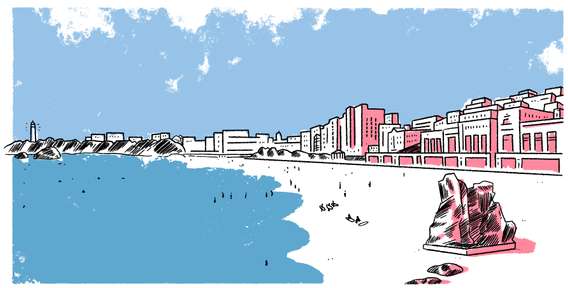
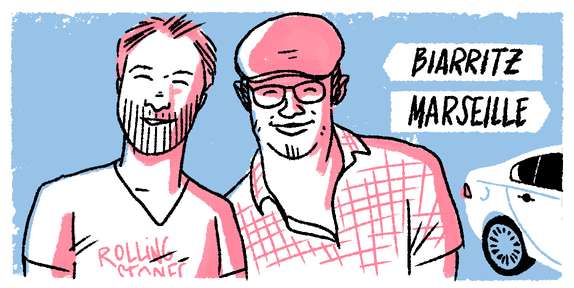

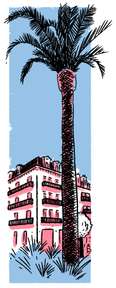

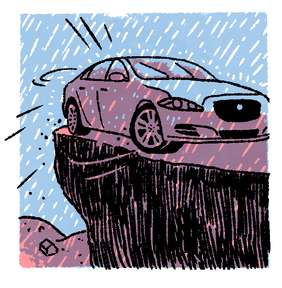

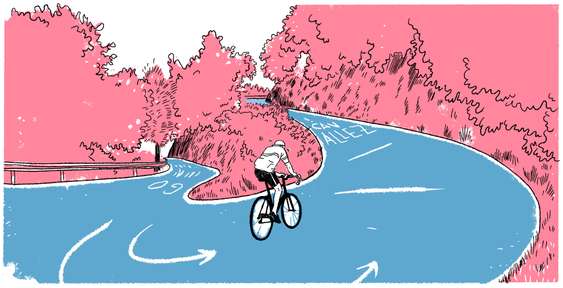

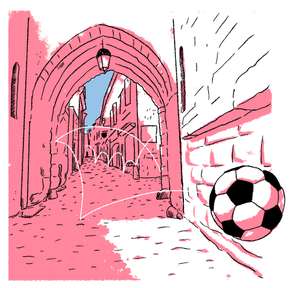

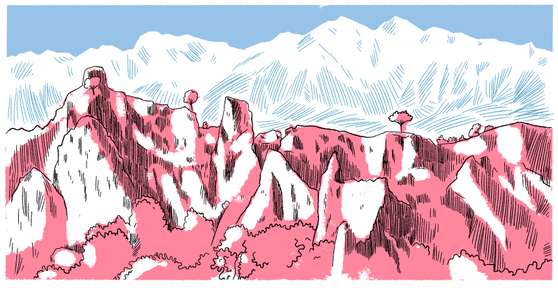

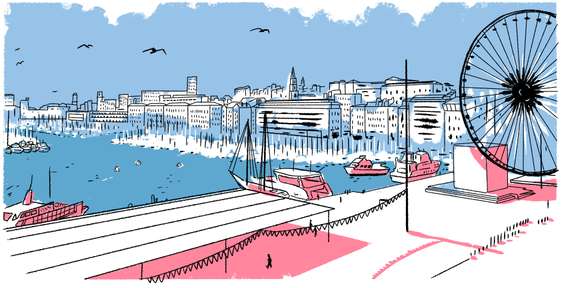

The Pyrénées dive south and here at Lescun are the first white caps high up and out of reach without a cable car. They’re awesome in the winter when you’re dressed to ski down them; otherworldly in the summer when you’ve spilt ice cream on your toes and rinsed them in the ocean just two hours before. The great French record producer Bertrand Burgalat offered some suggestions on an email, writing that Lescun is, “to me, one of the most beautiful places in the world” and that from in front of Aiguille d’Ansabère “it looks like a moon circus”. If Bertrand swapped the piano for the stylo I’d be out of a job.
Winding through the hills it’s 86 per cent guesswork to discern what’s road and what’s ravine; there are deathly drops into the valley below kept at bay by nothing but focusing on the black stuff and where it ends. This is proper roadtrip country: there’s no signal for Google Maps and the sat-nav’s spinning like a compass in the Bermuda Triangle; thank God we brought a bag of dates, a bag of nuts and four maps that we can’t read while we drive because they’re larger than king-size mattresses but much less wieldy. Where there are signs they are to places in Spain. We go on and the rain that was falling mainly on the plain has caught up and lashes down mainly on the Jag, throwing mud and stones in an avalanche. Why is it thrilling to be lost in a storm in a car in France? Jules finally takes off his Aviators and does some free-association swearing. Earth, Wind and Fire go on the stereo; it is time for something elemental.
And then the weather just passes through like an angry god with wrath fatigue and the wet roads steam in the blinding sun. In the Vallée d’Aspe a double rainbow marks the passing of the storm like Gay Pride staged by Cirque du Soleil: it is beautifully over the top. Down in the valley we go, then. Arreau is day two’s bed; a village for winter skiing and summer cycling alongside the Neste, a fast, bubbling salmon river on the banks of which an old boy in a beret stands statue-still teasing a line downstream. There is a street (maybe two); there is a hotel (maybe two); there is a bar with a TV playing France’s must-win match in the European football championships. A flirtatious, autumnal barmaid administers to a crowd of seven, three of whom are Irish (and lost) and two of whom are Dutch (and camping; almost the same); the other two are Jules and me. The condom machine in the men’s lavatory is rusty. An early night in Arreau is easy to achieve. Tonight the chance of gothic would be a fine thing indeed.
The next morning, though, Arreau is something else. It’s market day and trestle tables and backs of vans and flat-bed trucks and tablecloths laid on the cobbles are brimful of fish and veg and cheese and honey and liquor from the fruits of local hedgerows and more cheese and T-shirts emblazoned with images of Rihanna and Zinedine Zidane (not as a couple). It’s busy and bountiful and beautiful, like a Studio Ghibli vision of an impossible Old Europe. I fully expected a farmhand and a milkmaid to come tumbling out of a hayloft, blushing at the local priest and stifling laughter with fat fingers before scuttling in different directions but it wasn’t to be. So I bought a CD of local Pyrénéen hillsong and people scowled at the Jag as we drove out of town with a picnic lunch in the boot and Michel Daney et Daniel Epi’s “Des Landes aux Pyrénées” blaring out. We’re getting in the spirit – just a little ironically, perhaps.
This part of the Pyrénées is cycling country and a place of pilgrimage for fans of the Tour de France; a firm-buttocked ride away from Arreau are the cream of the steep and arduous mountain passes. They are the cols that count toward the Tour’s polka-dotted King of the Mountains jersey: Peyresourde, Portet d’Aspet, Tourmalet, Aubisque and Aspin. The Col d’Aspin is but a shaved leg from Arreau so we manfully step into the padded saddle of the Jag and climb with the riders dreaming of glory.
We twist through the hills and the views again, wreathed in mist or spotlit by shafts of mountain sun. The odd goat or herd of cud-chewing hill cattle look at the riders, mystified by the Lycra and the fluoro and the effort. Entreaties to extra speed for the leading lights and local heroes are scrawled on the road in paint, “Allez, Cav!”; “Go. Green. Bullet”; “Squalo dello Stretto!” (this ain’t no street up here, my friends). The summit is 1,490 metres above sea level and flat; in Tour terms it’s a classic but not a killer. We pat the Jag on the bonnet, tuck newspapers down our fronts and make our descent to warmer climes and easier climbs.
In the bas bit of the Haute-Pyrénées lies Lannemezan, a small-ish town that’s grown and shrunk with industry and the military. It’s been notable as a landmark in French and European psychiatry since the 1950s and the pioneering work of Doctor Henri Ueberschlag, whose idea it was to build the Parc de Loisirs de la Demi-Lune, an amusement park designed and run by the patients of the psychiatric hospital as therapy. What? Oh, yes. The rides may have been updated over the course of half a century but a sense of the homemade and hand-painted pervades. It’s a strange place: the Hôpitaux de Lannemezan backs onto a miniature railway, a pony-riding trail and a crazy-golf course (they call it mini golf for obvious reasons).
The Jag loves the big roads and doesn’t care about the heavy tolls down the raceway to Carcassonne. Up-country in Lens, England play Wales in the European football championships but this town in Languedoc is also hot with football fervour. (England will later be eliminated by Iceland, a country with a smaller population than Leicester, the team that shocked the world when they won the English Premier League. This limp exit will take place but three days after the UK voted to leave the EU.) The 12th-century citadel built by the Cathars to defend themselves from their own French king and the Vatican also has a siege mentality about it. The fans get wearying but the locals are patient; bar takings are healthy.
But what’s that smell? Cassoulet hangs heavy over Carcassonne. Beans and piggy bits in soup; so authentic that a local hasn’t eaten it in 30 years. I ask a waitress what they really call their speciality; “La poubelle” she says with stomach-turning candour. Of course there’s a kebab concession within the medieval citadel where shops selling swords named after goblin-slaying beard models (Aragorn, Jon Snow, Gandalf; there is also a Rambo) mix it with restored gargoyles, another miniature railway (on wheels, not rails), a pukka medieval coachpark (full) and a torture museum. Will the horrors of Isis be ironically funny in 800 years?
The Pays Cathare is full of old stuff; there is a dinosaur museum at Espéraza but the lovely old ciné in Limoux is now a centre du aikido; beyond, the countless vines of chateaux shimmer away to a heat-haze horizon. Rennes le Château is a tiny hilltop village that makes more than a few sous from the culture of the occult. There is an old church, a spooky gargoyle, a story about an unnaturally wealthy abbé and an inscription that apparently inspired Dan Brown to write The Da Vinci Code. The gift shop takes the baton and runs with it: nasty little models of goblins, dream-catchers, books on conspiracy theories and flying saucers, T-shirts decorated with soft-porn fairies, dvds about the knights templar, things obsessed with Genesis (not the band), models of the Sphinx and bags of “angel dust”. Even though we’re at the top of a hill we have a fish for lunch because we can’t hack la poubelle. We go onward and downward: to the sea!
To get a shift on south to the coastal plain the Jag breathes in a dress size as we swing it down the size-zero roads and catwalk turns of the Pyrénées-Orientales; overhangs, impossible tunnels, granite battlements, baffling topography and villages built like postcard fodder cling to the hillsides; a market square flashes by, a donkey, a well. In the canton (can you tell it’s hilly?) of St Paul de Fenouillet, as you leave Caudiès de Fenouillèdes in your dust, big and beautiful France opens out onto a plain that points to Narbonne. Granite cuts and bruises turn to fields of clay-court red; vines and olives mix it with windmills. Then the coastal road creeps up to the south: Narbonne’s cathedral of high Gothic; Jacques Tissinier’s sculpture “Les Chevaliers Cathares” sits high above the highway in high modern; skyscraping wind-turbines command the hills like giants’ toys thrown out of the pram. We roll on and on and on…
There’s no time to report from Cap d’Agde, the naturist capital of Europe, so alfresco copulation won’t be part of this story; neither will the fish restaurants of Sète or the surf-and-spliff Valhalla of Beauduc. We zoom towards Montpellier and just as the light aircraft of the little airport seem to hover over the highway, water is all around us: the Étang de l’Or above, the Med below and then we see the crazy contemporary citadel of La Grande Motte.
Who built Miami Beach on the Med? Jean Balladur did. La Grande Motte was built in the 1960s and 1970s from designs by the French architect who freaked out when he saw the Inca pyramids in Colombia and Mexico, dug Oscar Niemeyer’s Brasília and thought he’d have a go on virgin dunes on the way to Marseille. It’s a resort town built in a single, sculptural, modernist image that conjures the Super Cannes and Estrella de Mar of JG Ballard. You can imagine a murderous tennis coach or a pagan-king yachtsman holding sway over a community of rich, leisured and bored pharmaceutical salespeople and plastic surgeons addicted to prescription drugs, non-prescription drugs and nightly orgies of sacrificial sex and ritualised violence. I love it. God, it’s strange and bewitching even in low season where the best night out is crab ravioli and bottles and bottles of pale rosé in order to assuage the creeping fear that this is all a modern mirage. We wake up and cannot remember a thing.
The antidote to this optical illusion might be the Camargue, the salt flats that occupy thousands of hectares of the Rhône delta; home to flamingos, paddy fields and Front National voters. The roads narrow to single tracks with grass seeding itself through the centre, while the lanes become tunnels of bullrushes, cane and knotweed. It’s a flatland jungle where glimpses of big sky remind you that you need to leave; you don’t want to spend the night because the mosquitoes are like vampire bats. You can escape the Camargue via a spooky little town called Salin de Giraud by taking the dozen-car ferry across the Rhône at the point where it looks like the Styx; Charon in a fluoro tabard is only charging €5 a crossing so sail we do. But the underworld vibe continues a little. There’s a beguiling horror to the muddy flatlands through which you drive to get to Marseille from the Camargue: industry light and heavy, rusty railways fading into scrubland, cars left in lay-bys.
It’s a wasteland populated by prostitutes in primary-coloured skirt-suits appearing from derelict marshland farmhouses, a moonscape spectred by the sort of water towers and cement works that Bernd and Hilla Becher didn’t see fit to photograph. It’s an hour to Marseille and we put the lead boot to the gas.
Marseille’s is an afternoon of luminous sunshine and Biblical rain as the Jag swoops around the new port toward the old. The Quai des Belges teems with tourists, while the Avenue du Prado is a throng of scarves and shirts and singing on the way to the Stade Vélodrome, from where you can compare and contrast Espérandieu’s Basilique Notre Dame de la Garde and Le Corbusier’s L’Unité d’Habitation, masterpieces of the Byzantine revival and the modern. They are as emblematic of this city as the hustle, the food, the smell, the back-breaking steps and the dynamism. Marseille works up a sweat all day and gets a wash every time it rains; as we head to the Arab and North African street-markets of Noailles you can taste this souk of dry spice and seedy possibility on your tongue. Marseille is a wonder with reputations earned and unearned but it doesn’t care. One blemish is pickpockets but a far greater danger to the standing of the city is bouillabaisse, another local delicacy for the tourists that the locals themselves wouldn’t touch with a week-old crab claw. So supper is at Chez Étienne, home to the best rendition of Marseille’s de facto speciality: exquisite pizza. A moitié-moitié of anchovy-cheese and a portion of supions frits are just the sort of small squid required to go with lots more pale Provençal rosé. Oh, go on then: encore du vin, s’il vous plaît.
At midnight, taxi drivers want to take you to swingers clubs; since when was that the late drink of choice? The city needs a bit of a wash and gets another good one at 02.00; it’s time to sleep, perchance to dream, of France and wheels on fire and the Atlantic, the hills, the Med, the chance to toast a wild and civilised corner of a big continent that I love a little more than the last time. I wonder why? Vive l’Europe!


